The 2016 elections, although over, seem not to be. In North Carolina, the close race for the governorship is still in the news. Last week, Gov. Pat McCrory officially filed for a statewide recount. This will not happen until all the county boards of elections certify their results. This weekend, McCrory’s campaign offered to withdraw his demand for a statewide recount of the votes cast in the general election in exchange for a hand count of Durham County ballots reports The News and Observer.
” The state board also on Sunday declined to act on the appeal of the Durham County ruling rejecting a protest that election workers and malfunctioning computers mishandled some 94,000 votes. The state board said it could not act on the appeal until it had received a full record of a hearing the county board held.”
As the 2016 North Carolina governor’s race remains too close to call, Chris Cooper, professor and head of the Department of Political Science and Public Affairs, has conducted research on the subject of provisional ballots, which may determine the eventual winner of the election.
 Cooper, whose research focuses on state politics and policy, political communication, political psychology and Southern politics, has been a frequent figure this election season, being sought out by media across the country for his expertise.
Cooper, whose research focuses on state politics and policy, political communication, political psychology and Southern politics, has been a frequent figure this election season, being sought out by media across the country for his expertise.
Here, in his own words, Cooper shares his insights on the 2016 political buzzword of “provisional ballots.” This story was published by WCU on Nov. 17.
* * *
Election season is funny. Every few years, words become popular that we didn’t talk about before. In 2000, we began having conversations about hanging chads and butterfly ballots. In 2016 in North Carolina, the phrase of the day is “provisional ballots.” So, what are these provisional ballots and what do we know about them?
In the simplest form, provisional ballots are used when people show up to vote, but they’ve got something that prevents them from being recognized as a “true voter” in that election. In these cases, they are allowed to cast a “provisional ballot.” The reason for the provision is noted, but the vote is not recorded. This year, 61 percent of North Carolina’s provisional ballots were cast because there was no record of registration; 13 percent were because the voter moved, but did not report it to the board of elections; and, in 12.5 percent of cases, the voter showed up at the wrong precinct.
Election officials are currently in the process of ruling on whether the provisional ballots should be counted; if it is determined to be a true and fair representation of the intent of an actual registered voter, then the ballot is opened and recorded. While some states have had provisional ballots for years, the federal mandate requiring states to implement provisional balloting was not put in place until passage of the Help American Vote Act of 2002. A number of studies indicate that despite the uniformity of the mandate, states have implemented this law in very different ways.
Normally, provisional ballots constitute an administrative detail that the average North Carolinian doesn’t pay much attention to. After all, most elections (especially statewide ones) are decided by tens of thousands or hundreds of thousands of votes. This year, however, is different. Right now, less than 5,000 votes stand between Democratic gubernatorial challenger Roy Cooper and incumbent Republican Pat McCrory. The 60,481 provisional votes, therefore, could be the difference between a Republican and a Democrat governor.
So – what do we know about these provisional ballots. Fortunately, the North Carolina State Board of Election posts a file with the details of every provisional voter, including their name, the reason they cast a provisional vote, their address (if they report one) and more. By conducting some quick statistical analysis of this file, we can get a better picture of who is casting early votes in North Carolina and what they could mean for the 2016 election.
First, these data reveal that provisional ballots are relatively rare. In the average North Carolina County, there are nine provisional ballots cast for every 1,000 registered voters. This ranges from a low of about two provisional ballots for every 1,000 registered voters to a high of 27 per 1,000 registered voters. Provisional ballots are most likely to be cast in counties with high proportions of minorities and relatively low voter turnout.
Of course, it is partisanship that most folks are most concerned about. But here the data reveal no clear partisan advantage. Almost 38 percent of provisional ballots were cast by people who indicated they were Democrats, followed by 31 percent who indicated Republican identification, and 30 percent who indicated they were unaffiliated. These numbers are within one percentage point of partisan affiliation for all North Carolina citizens, and therefore don’t represent a clear favorite one way or the other.
Obviously there is much more to be learned here – about the people who cast provisional ballots, the counties they cast them in, and the reasons they supply for doing so. And once the final rulings come down, we will be able to determine whether the “accepted” provisional ballots differ systematically from those that are denied. And, most importantly, we’ll soon learn whether these provisional ballots hold the keys to 200 N. Blount St. in Raleigh.



